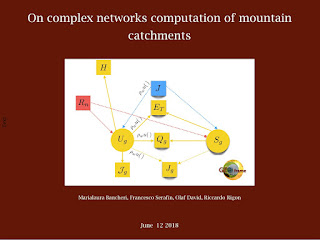From June 12 to June 14 2018 in Trento there is the 5th European IAHR conference. I am convening (and also presenting a contribution) which derives from our modelling within the GEOframe system.
The scope of the presentation is to inform about functionalities of GEOframe and something of what it is hidden under the hood. Clicking on the figure above, please access the pdf of the presentation.
My reflections and notes about hydrology and being a hydrologist in academia. The daily evolution of my work. Especially for my students, but also for anyone with the patience to read them.
Monday, June 11, 2018
Wednesday, June 6, 2018
Snow related Ph.D. position (the Stradivari snow project)
The Stradivari project research aims to build better tools for analysing the processes of the hydrological cycle. The project is more focused on the tools (building the violin) but it does not forget the music that has to be played. It is conceived to account for hydrological processes interactions and feedbacks, and develop new mathematics (equations) for their description. Use of appropriate contemporary numerics is also part of the project. The overall project builds on the foundations given by the GEOtop (http://abouthydrology.blogspot.com/2015/02/geotop-essentials.html) model and the GEOframe-NewAGE (http://geoframe.blogspot.com/) infrastructure.
It is time to move on the generation of snow models. The computation abilities and the physics of snow are now much better known than thirty years ago. However, most of the snow model are based on parameterisations which should be updated. We start from the experience made in GEOtop (versions 0.*,1.* and 2.*) which is capable of reliable snow height, temperature and densities, at operational level over all the Alps, but we look also to the experiences made by CROCUS, SnowPack and Alpine 3D. In particular GEOtop use highlighted various issues that we plan to overcome with a new version of the model, which requires both deepening the thermodynamics of snow and its numerical implementation.
In synthesis we identify the following aspects to be improved:
- Actual GEOtop snow model is 1-d. It can improved including the vapor phase movements explicitly. Besides, we can add modules to have a better account for: density, viscosity and, adding the vapor phase, type of grain.
- The physics. Analysing the thermodynamics to keep out of the future formulation empirical parameterisations of the processes which revealed obsolete;
- Adding Richards equation for water percolation;
- Analysing the separation rainfall, snowfall through a more physical modelling than actual;
- the description of deposition on canopies, and subsequent effects of vegetation on sublimation; the effect of slope and topography characteristics on snow deposition and sublimation
- blowing snow in complex terrain
- assimilation of hydro-meteorological data and calibration
- integration with remote sensing data
The project has also some practical outcomes that are related to:
- the avalanche triggering
- the water availability due to snow and glaciers melting (both in the short and long terms)
- the hydroelectric production
The candidate will take care of implementing, besides the code, the appropriate procedures for continuous integration of the evolving source code, and s/he will be also asked to maintain a regular rate of commits to the common open platform. Despite these conditions, and being free and open source, the code will be intellectual property by the coder. This will be guaranteed also by the components-based infrastructure offered by OMS3, which allows to better define the contributions of anyone.
The implementation part will be followed, accompanied by testing activities, either for mathematical consistency, than for physical consistency with experiments and field measurements.
The Ph.D. student is intended to produce, besides working and tested codes, also at least three papers in major journals (VQR Class A), of which, at least one as first Author. Duration of the doctoral studies could be three or four years.
This project can enter either the curriculum C (Environmental Engineering) or the curriculum A (Modelling and Simulation) of our doctoral school.
Further information of the policies of the research group can be found:
Evaporation and Transpiration
This contains the video related to my interpretation of evapotranspiration.
The thermodynamics of evaporation
Definitions
Transport of vapor in the atmospheric boundary layer
Evaporation from soils
Transpiration
The energy and mass budget
The Penman-Monteith approach
The thermodynamics of evaporation
Transpiration
The energy and mass budget
The Penman-Monteith approach
Tuesday, June 5, 2018
From where do waters arrive
You cannot have an aqueduct if you do not have water to resupply it. So water comes from springs, wells (i.e. from groundwaters) or intakes (surface waters).
Wells
Intakes
Wells
Subscribe to:
Posts (Atom)

